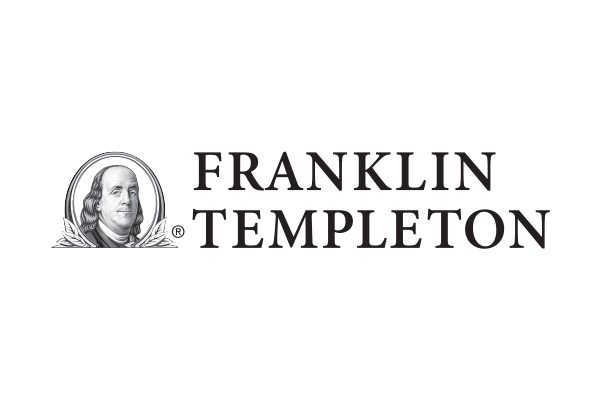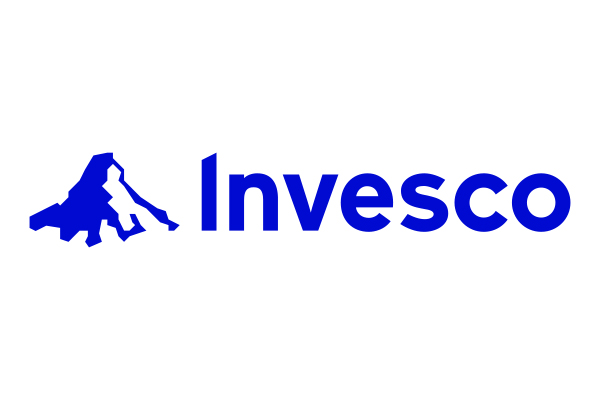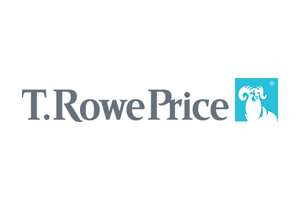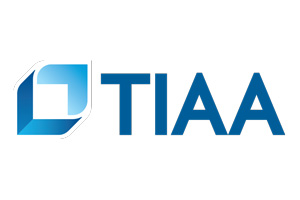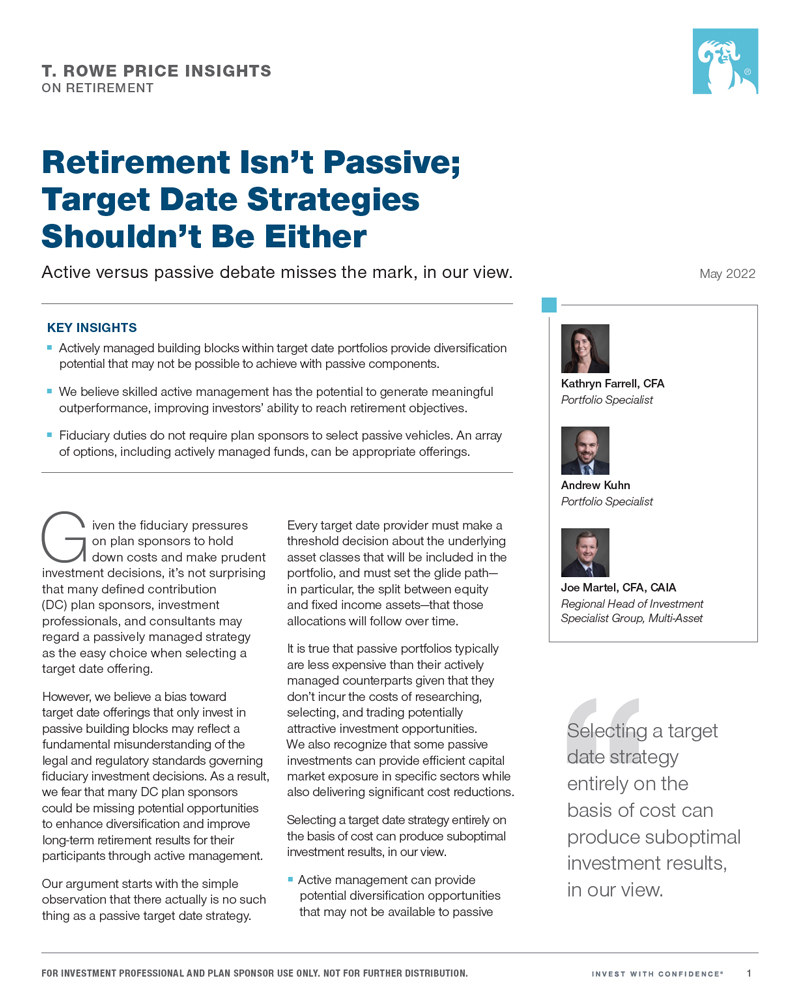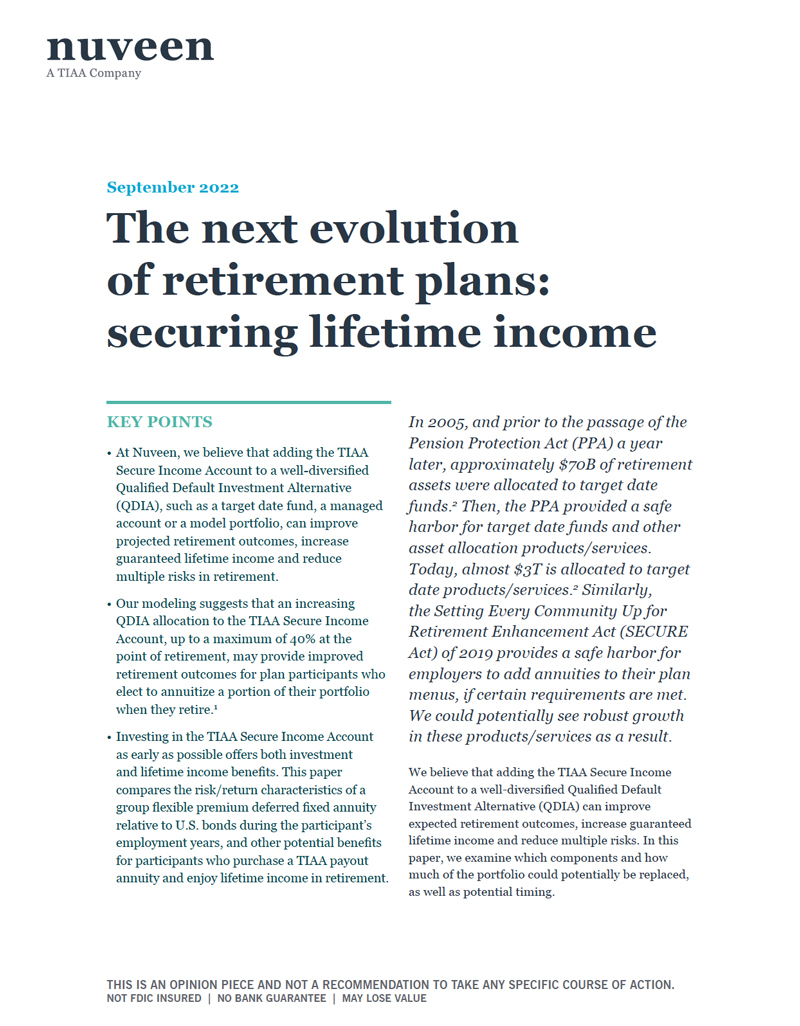
A RESPONSIVE STANCE
Plan sponsors are in a period of review and refinement of their defined contribution plans and employee financial benefits, with a view toward improving the overall retirement security of their workforce. They are engaged in optimizing plan design to address the current market environment, shifting workforce demographics and employee expectations. In addition, new technology and data advances have made it possible to deliver plans that are customized for participants. The process can be challenging to implement, given the additional data inputs required and multiple considerations involved in adopting lifetime income solutions.
“The biggest observation we have seen post-pandemic is the accelerated trend around more holistic views of overall financial wellness, or what we would call financial planning, for all U.S. workers,” said Kevin Murphy, senior vice president and head of workplace retirement distribution at Franklin Templeton. “Financial wellness is a trend that plan sponsors embrace and leverage as a real benefit compared to their health and welfare benefits, voluntary benefits or similar options. The pandemic increased awareness of, and the need for, financial wellness. A very efficient way to deliver that is through the workplace.”
Trends in DC: Refining Plan Design Webinar

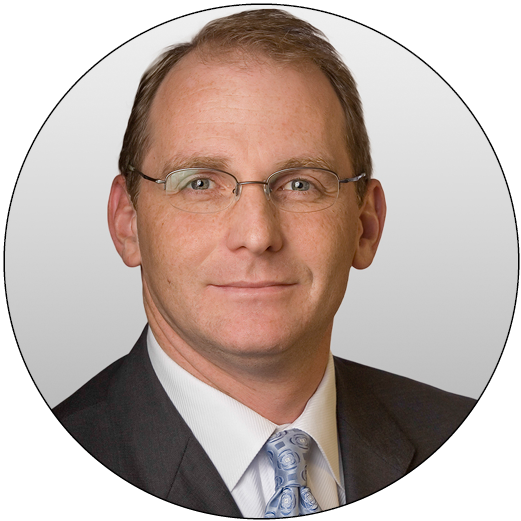

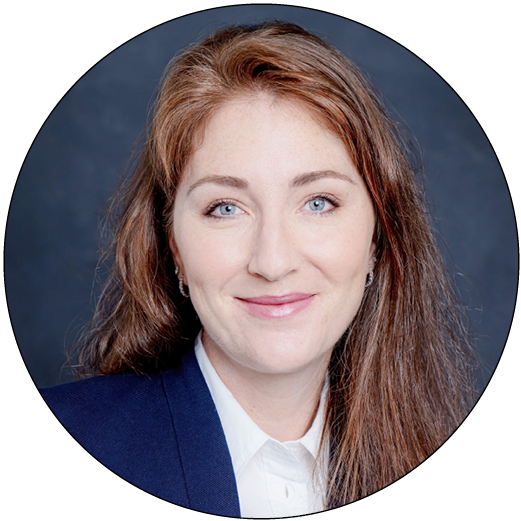
Focus on wellness
“Financial wellness, including retirement wellness, [are] fitness around the components of retirement, including income planning and other elements,” said Tamiko Toland, managing director and head of lifetime income strategy at TIAA. Many plan participants expect their employers to take this holistic approach toward their overall financial situation. “When there is that trusted relationship, [employers can deliver] information and education, particularly across the different life stages. As [participants] approach retirement and have been saving with their employer, having a package of information and services that support their retirement makes sense,” Toland said.
Particularly since the pandemic, plan sponsors have realized that helping employees better manage their current financial situation can have a beneficial impact on retirement savings. “Programs to help participants manage loans and manage their student debt are critical. There is evidence that when participants feel more confident and secure about some of these issues, they are more likely to save more, and everyone benefits,” said Greg Jenkins, managing director and head of institutional defined contribution at Invesco. This focus is being adopted across DC plans of all sizes. “Record keepers are doing work to make this more accessible to smaller employers who may not have the resources or the budget to have a custom-designed program,” he said.
Preference by both sides
The focus on improving financial wellness and employee engagement is driven both by worker expectations that have shifted since the pandemic as well as plan sponsors’ preference to retain employee assets in-plan subsequent to retirement.
Franklin Templeton's Voice of the Ameican Worker study, fielded by the Harris Poll late last year, researched employee expectations of employers and how the retirement plan can be used to attract and engage talent, said Murphy. This survey is under development for its third year. “Sixty-seven percent of respondents said that because of the COVID-19 pandemic, workplace changes have made folks reassess what they’re looking for from their employer. When you look at the importance of salary versus benefits, responses are split down the middle, with 51% saying salary is the most important and the other half, 49%, indicating that benefits and employee well-being are the most important factors when weighing a new job opportunity,” he said. (See graphic.)
“Especially in today’s environment, where there’s a lot of competition for quality workers, sponsors have a greater awareness of the need to provide competitive benefits. There are a lot of reasons for sponsors to do this. I think that some of the perception has been that lifetime income is an altruistic benefit, that it’s something that sponsors would do because they just want to do the right thing for the participants, but the reality is that it benefits everybody,” said Toland at TIAA.
A new lens on DEI
An emerging trend among DC plan sponsors is to broaden the lens on plan demographics to include the racial composition of their workforce.
Historically, retirement plan demographic analysis has focused on identifying participant cohorts based on age, savings rates or gender. Today, plan sponsors are increasingly including racial cohorts in their analysis. “It is early days in terms of fully exploring the intersection of retirement and diversity, equity and inclusion, or DEI, but there is growing recognition among plan sponsors that financial differences exist among racial cohorts. We see more plan sponsors seeking to understand who their plan is working for and who it might be unintentionally leaving behind,” said Jessica Sclafani, senior defined contribution strategist at T. Rowe Price.
Read: Market Setbacks Don’t Need to Set Back Retirement Plans
Plan sponsors that have embarked on this type of analysis are typically supported by their organizations’ broader DEI efforts, she added. “A result of looking at the plan through the lens of racial cohorts is that some plans [are] rethinking how they implement automatic plan design features or even revisiting their target-date selection.”
OPTIMIZING THE INVESTMENT MENU
Several DC plans have diversified their investment menu, or are considering such a move, in order to help their plan participants better navigate through challenging market environments, such as the current situation of rising interest rates and increased market volatility. New or enhanced additions have included real assets and alternatives, and this effort is apt to continue even after the stabilization of the current bout of inflation. In addition, as part of a comprehensive review of the investment menu, plan sponsors are looking more closely at sustainability investing and their active-passive allocations.
“The effects of these choppy markets are a reminder that most DC plans are lacking in diversification compared to other institutional pools of assets. Many plan sponsors are thinking about areas of market exposure. It certainly has changed the mindset, coming from the long-term bull market we have had. For example, we have seen an uptick in interest in real assets as an area where you might find positive returns in these kinds of environments. We have also seen renewed interest in stable value among larger plans that don't have it. Plans that do are re-evaluating and making sure they have the right manager,” said Jenkins at Invesco.
Inflation protection
The need to diversify has intensified in the current rising rate environment and the tightening cycle by the Federal Reserve. “Plan sponsors are actively looking at inflation protection or real-return options and, in general, these offerings tend to be multi-asset or multi-manager options,” said Drew Carrington, senior vice president and head of U.S. institutional defined contribution at Franklin Templeton.
Read: Separating facts from perception
While the equity menu tends to be diversified, that may not be the case in fixed income. “Plan sponsors recognize that they offer [plan participants] the ability to build a fairly diversified portfolio in the equity side, but most plans offer minimal diversification options in the lower risk end of the spectrum,” Carrington pointed out. They can consider a broader set of fixed-income options, including global fixed income, high yield, emerging market debt and other categories, like real estate, which “is less risky than equities, and the correlation benefits in a diversified portfolio are significant. We are seeing plan sponsors actively look at that lower end of the risk spectrum in their plan menu,” he said.
Many plan sponsors have realized the need for greater diversification as they look ahead at expected returns for traditional assets and are increasingly concerned about rising inflation, noted Sclafani. T. Rowe Price added inflation-hedging assets to its target-date glidepath in 2010, implementing real assets within the equity allocation and shifting bond exposure to short-duration Treasury Inflation-Protected Securities in the fixed-income allocation. “We thought about these allocations as long-term insurance policies based on the premise that over a long-term time horizon, such as that of retirement, we were likely going to encounter periods of rising inflation,” she said. “Today, these decisions are pulling through for our participants.”
Another approach to address current market challenges is to provide guaranteed income that can reduce the reliance on traditional asset classes and their return volatility in an inflationary environment. “That is one of the reasons we see considerable interest among plan sponsors in our solutions that incorporate fixed annuities during accumulation to stabilize returns and provide a guaranteed income after retirement,” said Toland at TIAA. Rates are moving up, and rate volatility can be very challenging regarding the expectations around bond fund returns, she noted. “This challenge underscores the value of other vehicles that provide a fixed-income return, but with less exposure to that volatility, particularly fixed annuities. There is no perfect hedge for inflation, but it’s undoubtedly one of the strategies that can help, since steady income allows the participant to stay engaged in more volatile assets that help deal with inflation concerns,” she said.
ESG integration
DC plan sponsors continue to wrestle with how best to incorporate environmental, social and governance factors in their investment approach. While sustainability in investing is finding increasingly vocal support among their employees, it is not yet required by regulatory or legislative action.
T. Rowe Price’s 2021 DC Consultant Study illustrated how ESG investing can represent a unique communication or engagement opportunity with participants. “Interestingly, our data suggested that consultants believe sponsors currently consider ESG primarily from a participant demand perspective instead of an investment perspective,” Sclafani said. Consultants identified ‘driving positive engagement with participants’ as the most influential objective that was motivating plan sponsors to consider incorporating ESG factors into the employer retirement plan. “As plan sponsors continue to explore ESG, we expect investment concerns, including the potential to contribute to return or mitigate risk, will rise to the top as primary objectives motivating plan sponsors to incorporate ESG considerations into the plan,” she added.
A blend of active and passive
Another ongoing discussion impacting investment menus is the active-versus-passive management debate, and many plan sponsors are approaching optimal plan design as a blend of both strategies, depending on specific circumstances and asset class. While fees are a key consideration in the decision for many sponsors, it is not the only one in determining the optimal solution for participants.
TIAA’s approach is for an open-architecture model that allows for a blend of active and passive approaches, said Toland. “We have seen a ton of fee pressure, but hopefully [there’s] a broader recognition that fees are not the only thing to consider. If [only] fee pressure drives people towards passive investments, that doesn’t necessarily serve the sponsor and the participants.”
Read: Shifting DC Times: Behind the Scenes in LA
The goal is to allow participants a different point in their retirement savings journey to create portfolios that help them achieve their retirement objectives, said Carrington at Franklin Templeton. “However, plan participants may not have the investment acumen to manage these options in their overall allocation and consistently rebalance their portfolios,” he said. “One may wish to include [some] types of diversifying asset classes — where active management may offer an advantage — in a custom target-date fund or an adviser-managed account, where a professional intermediary is doing the asset allocation. Anyone running a long-horizon portfolio wants the best combination of risk and return at the lowest cost over that entire horizon. One should be interested in the net value added, which may come in the form of better returns, or it may come in the form of lower risk,” he said.
“The active-passive debate is moving to a new phase where the answer doesn't need to be an either/or decision, said Sclafani. T. Rowe Price’s recent survey showed that at least 90% of DC-focused consultants and advisers preferred implementing equity strategies using both active and passive. “For most fixed-income strategies, there was an incrementally stronger preference for active management, capturing three-quarters of the consultants and advisers as the preferred implementation method in the core-plus and high-income bond categories,” she noted. (See chart.) “We think many plan sponsors and participants were disappointed by how their fixed-income portfolios performed this year and expect there will be more interest to diversify participants’ fixed-income exposure beyond a core or core plus only approach, whether it is offered within a target date or a white-label fixed-income option on the core menu,” Sclafani said.
AUGMENTING RETIREMENT SECURITY
While delivering guaranteed retirement income or lifetime income solutions continues to be top of mind for many DC plan sponsors, the significant deliberations that go into choosing how to provide this benefit and the resources required to implement it have led to a slow pace of adoption thus far.
“An important concept that we are discussing with plan sponsors is that of a retirement income ecosystem that offers a range of investment solutions and a holistic experience for retired participants,” said Sclafani at T. Rowe Price. “This can include both investment solutions and access to guided tools and advice to meet the broad range of retiree needs and objectives, as opposed to a single solution.”
Data from T. Rowe Price’s 2021 DC Consultant Study explored preferences for the various retirement income solutions that are available and identified that the most interest or demand was for systematic withdrawal payments and managed payouts. “This doesn’t mean that insured products like annuities don’t have a role to play in the broader retirement income ecosystem,” Sclafani noted. In fact, the firm is exploring a deferred-income annuity solution that can help participants who are particularly concerned about longevity risk.
While everyone is talking about guaranteed income, how it is adopted and how it will be delivered is up to plan sponsors, said Jenkins at Invesco. “Much of it comes down to the plan sponsor’s philosophy. Some plan sponsors are more interested in insurance-based annuity-type solutions, [and] others are looking for more investment-based solutions that may be more flexible,” he said.
Participant attitudes
According to TIAA — which has long delivered annuity solutions to the 403(b) market and has seen more interest from 401(k) plan sponsors as well — a driving factor in industry adoption is the desire from plan participants to access solutions that address longevity risk. “The end state that many of us see is that lifetime income within the DC plan will become the standard. Participants want it and, in many cases, they expect it, said TIAA’s Toland. “You can see from the data that participants mistakenly believe that a target-date fund does provide guaranteed income, and it is surprising to think that folks believe that they are going to be getting a benefit that they do not already have. It is high time for sponsors to consider whether it makes sense to provide lifetime income,” she said.
“Another key aspect is that the messaging around retirement income stability may not be getting through to participants. Invesco’s recent research on retirement income found that only 4 in 10 participants said they remembered receiving any communication about turning their balance into income in retirement, whereas nearly 80% of plan sponsors said they had done those communications,” said Jenkins. (See chart.) Interestingly, the research also showed a wider interest across generations. “We found that younger participants were surprisingly more interested in retirement income offerings than you might have thought. They wanted to know where the train is going and how they can turn savings into income down the road,” Jenkins said.
Balancing philosophy and need
As plan sponsors grapple with the question of how to incorporate guaranteed retirement income into the DC plan, the optimal approach will differ by plan philosophy and participant needs. “The best answer will be a combination of solutions that helps participants figure out the proper allocation, the right mix between liquid investments, spending down your portfolio and guaranteed structures, whether using deferred or variable annuities,” said Carrington at Franklin Templeton. “Record keepers, consultants, advisers and plan sponsors are all trying to tackle that question, but a single solution based on the participant’s age is unrealistic,” he said.
Besides the challenges of selecting an approach, implementation of guaranteed income raises several considerations as well. For instance, “Do you default people into a retirement income option, or do you have it be an opt-in program?” said Jenkins. Developing these programs is expensive for the industry, record-keeper connectivity is critical and additional communications are needed, he pointed out. “If it is an opt-in program and only a small percentage of participants use it, will that be enough to move the needle and make all this worthwhile? It will need to work for [both] plan sponsors and participants, because it will require additional resources and expense for everyone.”
Wherever they are in the retirement income journey, it is evident that plan sponsors are closely following industry developments. “Every plan sponsor is coming at this from a slightly different angle, and long-term there will need to be multiple retirement income options to serve these needs. There are pluses and minuses with in-plan and out-of-plan solutions. This market’s evolving very quickly, and many plan sponsors are waiting to see how much more flexible the products will get, how far costs can come down and what we can do for plan participants right now in anticipation of better retirement income solutions coming to market in the future,” said Jenkins.
A FOCUS ON INDIVIDUAL OUTCOMES
DC plan sponsors are exploring ways to bring personalization and customization to their investment menu that can better serve individual employee situations. From refining target-date fund structures to adding managed accounts for those closer to retirement, the recognition of a more individualized plan approach has been bolstered by advances in data availability.
“There are a lot of different ways that plans can be customized. Personalization can happen in many ways, whether through a managed account or individual advice. Technology is central to providing better access and making these options as affordable as possible,” said Toland at TIAA. “While we are already there, to some extent, much work is still needed to expand the array of services available to participants by connecting different services and pulling in outside account information” to get a full financial picture of each plan participant, she said.
Franklin Templeton’s Voice of the American Worker study showed that employers are faced with a real challenge to provide competitive, personalized programs that are more than just a DC plan or a 401(k) plan with a match,” said Murphy. “They need to consider the hybrid work environment and how that plays into the benefits offered. They need to think about pay structures and similar program issues,” he said.
“Some asset managers are taking a more personalized approach by designing personalized target-date funds. These solutions are an evolution from the long-utilized target-date fund and [they] now consider more data points in order to better align each individual to an asset allocation more suited to their unique goals,” Murphy said. “While a step in the right direction, we believe a competitively priced managed account provides more holistic advice, which according to our data, is desired by a majority of working Americans.”
Many paths forward
Some plan sponsors have taken the approach that the qualified default investment alternative, typically the target-date fund, may better serve most younger participants and those with smaller average portfolios, while personalization is more appropriate closer to retirement. They “use target-date funds as a QDIA for younger participants until they reach a certain age, and then provide a managed account as the default for older participants,” said Jenkins at Invesco. “It makes a lot of sense, since older participants typically have more outside assets, and they have more complicated financial situations. That is where managed accounts can really add value. Think of it like a prescription for each participant, making sure they’re at the right risk level and considering their full financial picture,” he said.
T. Rowe Price’s multi-asset team has conducted robust research on the potential benefits of personalization through managed accounts, Sclafani said. These can be offered as a target-date alternative for participants looking for a more customized experience and also serve as a component of a retirement income ecosystem, she noted.
Read: Voice of the American Worker Survey
With the accelerated focus on delivering personalization in DC plans, new technological solutions that help to connect record-keeper data are emerging. “What we have seen arise is middleware to support those possibilities. This focus on the record keepers is so they don’t have to deal with the hassle of connecting with lots of different solution providers and can have one set of data connections that will support a variety of other solutions,” said Toland at TIAA. She said she expected to see an evolution of solutions that help to deliver a comprehensive data approach on a participant’s full financial profile.
Given the many trends and commensurate challenges on the minds of DC plan sponsors, there is no industry consensus on the optimal way forward nor the technology or resources needed for full-scale implementation. Different industry providers “have different ideas about the ideal end state and how we’re going to approach that end state,” Toland said. “We are very early in this process. We see a lot of different models, different methods and different technologies. This is very good for the sponsor in the sense that they have a lot of different choices, but it adds complexity when moving forward. We are nowhere near defining what the industry will look like in a decade.”
